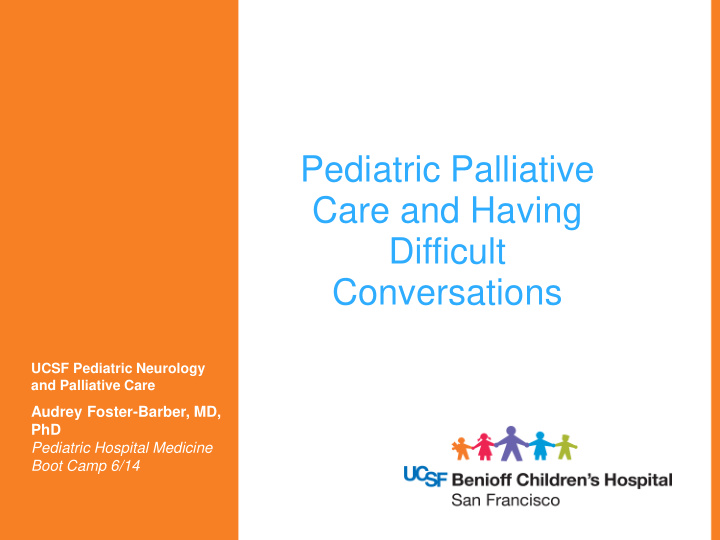



Pediatric Palliative Care and Having Difficult Conversations UCSF Pediatric Neurology and Palliative Care Audrey Foster-Barber, MD, PhD Pediatric Hospital Medicine Boot Camp 6/14
Palliative Care • A philosophy • A care model • Comprehensive care for children with life-threatening conditions • Active, multi-disciplinary, inpatient and outpatient • Address physical, emotional, social and spiritual elements • Concurrent care- can continue curative or disease directed treatments • Goal is to maximize quality of life and relief of suffering through recovery or death and bereavement 2
Model of Concurrent Palliative Care Therapy to Modify Disease End of Life Care (curative or life prolonging) (Hospice) Bereavement Care Palliative Care Presentation Death Therapy to Relieve Suffering And/or Improve Quality of Life Acute Chronic Advanced Illness Continuum Life-threatening
Criteria for referral to PC Primary Criteria Secondary Criteria • The surprise question • Admission to long term care facility • Frequent hospital admissions • Out of hospital cardiac arrest • ICU stay >7 days • Limited social support • Difficult to control physical or psychological sx • Awaiting or deemed ineligible for solid organ • Decline in function, feeding transplant ability, weight • Discussion of G tube, • Disagreements among staff, tracheostomy, or dialysis patient, family re major medical decisions • No documented advanced directive 4
Opportunities to initiate PC • Initial diagnosis • First bad news • Acute decompensation, admission to ICU • Developmental steps- age of assent 12 th or 13 th birthday, 18 th birthday 5
Tasks of Early PC • Identify problems or challenges, focus on QOL • Explore hopes and goals • Facilitate communication between subspecialists and family • Identify community resources • Address needs of patient and family • Anticipate decisions 6
Concurrent Care for Children • Part of the Affordable Care Act signed 3/2010 • Section 2302 Concurrent Care for Children • Allow continuation of developmental and disease- directed or curative therapy while obtaining hospice and related services • State based Models- eliminate the need for <6mo prognosis, add Care Coordination, Expressive therapies, Family counseling 7
8
Family meetings/Breaking bad news • To gather information • To provide information • To provide support • To develop realistic goals and treatment plan 9
The meeting as 3 course meal • Appetizer- Meeting Preparation • Main Course- the meeting • Dessert- Provider Debrief 10
SPIKES • Setting • Perception • Invitation • Knowledge • Emotions • Summarize 11
Setting • Team- who should be there, who will lead, interpreter if needed? • Review the medical facts • Tissues, water, privacy • Ditch the pager if you can • Set a time limit 12
Perception • Ask first, talk later • What does the patient or family know? • What are their concerns? • Ask open ended questions 13
Invitation • Find out how they would like information delivered -every detail vs broad brush-strokes -will patient be included? What family members? 14
Knowledge • Provide clinical information • Small bites of information at a time • Have them repeat it • Fire a warning shot before bad news • Don’t say “I’m sorry” • Use real words- not medical jargon, not euphemisms 15
Emotions • You cannot prevent distress from bad news • Silence is important • Pre-empt guilt if possible • Words are mighty- do not say “there is nothing we can do” • Frame code discussions as one type of treatment vs another (resuscitation vs aggressive comfort measures) • Burden vs Collaboration • MD emotions are O.K. 16
Summarize • Repeat, Review, Revise • Redirect hope in realistic directions 17
• www.getpalliativecare.org • www.nhpco.org/pediatrics • www.capc.org • www.cms.gov/medicaidgeninfo/stateplanlist.asp • Buckman, R. A. (2005) Breaking bad news: The S-P-I-K-E- S strategy. Community Oncology, 2, 138-142. • Weissman, D. E. (2011) Identifying Patients in Need of a Palliative Care Assessment in the Hospital Setting. A Consensus Report from the Center to Advance Palliative Care. Journal of Palliative Medicine, 14(1), 1-6. 18
Recommend
More recommend